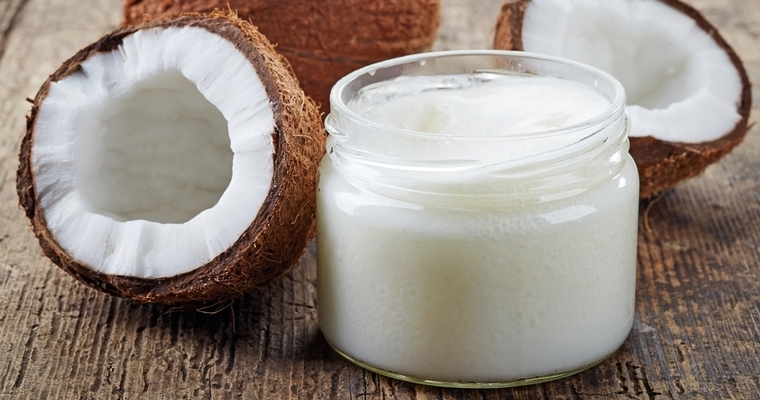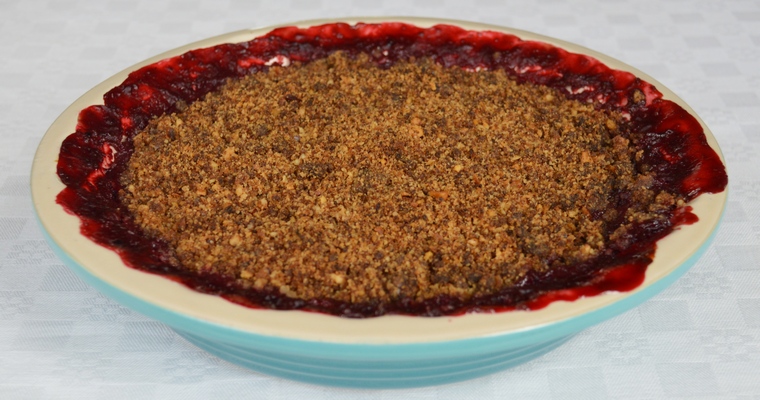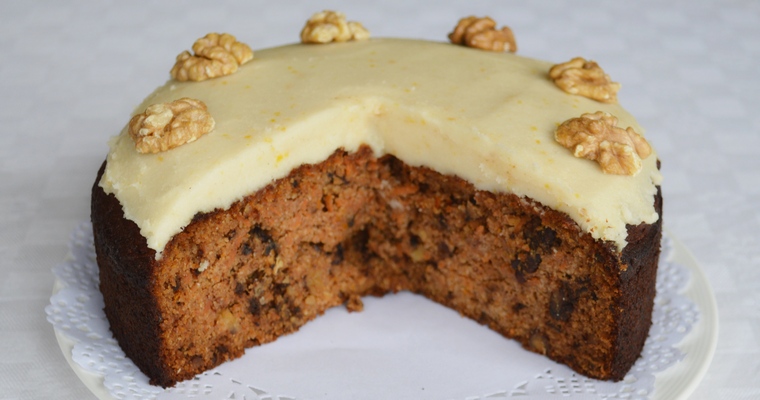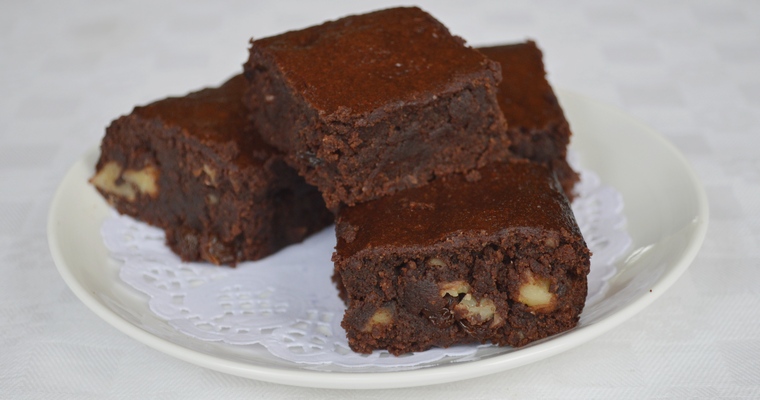How to replace butter with coconut oil for delicious dairy-free cakes, biscuits and pastry. Includes conversion table and instructions for adapting recipes
Technique
01. What is the role of butter in a baking recipe?
02. Why are solid fats preferred for baking?
03. What different types of fat can be used for baking?
04. Why replace butter?
05. Why use coconut oil for baking?
06. What’s the difference between ‘Virgin’ and ‘Refined’ coconut oil?
07. How will coconut oil affect the flavour?
08. How will coconut oil affect the structure and texture?
09. What happens if I replace butter one-for-one with coconut oil?
10. How do I convert an amount of butter to coconut oil?
11. What adjustments will I need to make to the recipe?
Recipes
12. Which recipes work best with coconut oil?
01. What is the role of butter in a baking recipe?
Butter acts as a lubricant in baking recipes, melting when heated. This weakens the structure of bakes by preventing the sticky, structural elements like gluten and egg proteins from bonding together. In cakes, this results in a soft crumb that crumbles when sliced. In pastry, this results in a flaky crust that falls apart. This lubricating effect also enhances the eating experience, creating a sensation of moistness in the mouth.
Properties of butter:
- Hydration: butter comprises 20% water and 80% fat. Unlike water, fat does not evaporate or become absorbed during heating. Instead, fat melts into the batter to lubricate the flour. This creates a moist bake.
- Texture: butter helps bakes to rise by trapping air, and by releasing steam as the water content evaporates. This creates a light and fluffy texture. Butter can be creamed with granulated sugar to create tiny pockets of air in the batter during the mixing stage (mechanical aeration). During the heating stage it melts, creating a channel for the bubbles of carbon dioxide that are produced by raising agents like baking soda (chemical aeration).
- Structure: butter reduces gluten formation and egg protein coagulation (it coats flour particles in an oily film, and it competes with eggs proteins to bond to other egg proteins). This weakens the structure, creating a tender crumb that is crumbly without being dry.
- Flavour: butter has a pleasant flavour and a rich mouthfeel. It has a low melting point, which means that it melts in the mouth. This creates a bake that feels moist without being greasy.
- Crust: butter promotes the formation of a flavoursome brown crust, as milk solids contain sugar and protein. When heated, sugars and proteins undergo chemical reactions that create deeper flavours and colours (caramelisation and the Maillard reaction). Browning can only happen once all the water has been driven out and the surface temperate can exceed 100°C/210°F. Fat helps to raise the temperature by acting as a heat transfer agent.
02. Why are solid fats preferred for baking?
Fats are classified according to whether they are solid at room temperature or liquid. Liquid fats are less versatile to bake with because they have a weakening effect on the structure. Oils cannot be creamed with sugar to create aerated batters, nor can they be rubbed into flour to create flaky pastry dough. Instead, they must be stirred directly into the dry ingredients. This results in a dense structure and moist texture. If the oil is not thoroughly incorporated during the mixing stage, then the finished bake can be unpleasantly greasy. Egg yolks, honey and xanthum gum are all emulsifiers that help to suspend the oil particles in the batter to prevent greasiness.
(butter, coconut oil, lard, suet)
- solid at room temperature
- range from white to pale yellow in colour
- neutral flavours
- higher melting points
- stable when heated
- best stored in the fridge
- light, delicate sponge cakes
- cake frosting / fillings
- pie crusts
- pastry
- steamed puddings
Good for light and fluffy cakes like a Victoria sponge, as solid fats can be creamed with granulated sugar to trap air. Butter is also creamed with powdered sugar to create a thick paste that can be sandwiched in the middle of cakes and muffins (buttercream).
Lard and butter may be rubbed into flour to make biscuits, pie crusts and pastry. The rubbing actions coats the flour particles in an oily film, creating a crumbly texture that falls apart.
Suet has a particularly high melting point, which adds lightness to steamed puddings. By the time it melts, the batter has had time to set around the suet lumps, leaving behind a regular network of air bubbles.
Biscuits made with butter and coconut oil tend be thin and crisp, as these fats have lower melting points. This causes doughs to spread more in the oven before they set.
(olive oil, nut oils, seed oils, vegetable oils)
- liquid at room temperature
- range from light gold to amber to pale green in colour
- distinctive flavours
- lower melting points
- prone to becoming oxidised or rancid when heated
- best stored in a cool, dark cupboard
- moist, dense cakes
- strongly flavoured bakes
- soft, chewy cookies
Good for bakes which require moistness, like banana bread. Also good for bakes with strong flavours like gingerbread cake. The distinctive flavours of plant-based oils need to be balanced with other strong flavours to avoid overwhelming.
Liquid fats cannot be creamed with sugar. Instead, batters are prepared using the all-in-one method, where all the ingredients are mixed together at the same time. Bakes will have a flatter, denser structure, and require a chemical raising agent like baking soda.
Biscuits hold their original shape and do not spread much in the oven, since the fat was already a liquid when the raw dough was formed.
03. What different types of fat can be used for baking?
Whether a fat is a solid or a liquid is determined by its chemical structure. Fats are made up of long chains of carbon atoms, linked together by single bonds (C-C) or double bonds (C=C). Double bonds can split apart and react with hydrogen, so that one bond continues to link across to the next carbon atom in the chain, while the other bond links up to an isolated hydrogen atom. In saturated chains, every double bond in the chain has split apart and bonded to a hydrogen atom. When a chain holds as many hydrogen atoms as possible, it is described as ‘saturated’. This creates a stronger, denser structure, as double bonds introduce a kink to the chain, forcing the carbon atoms further apart. Fats chains that only have one double bond are described as ‘monounsaturated’ (mono- meaning one), while fat chains that have more than one double bond are described as ‘polyunsaturated’ (poly- meaning many). The more double bonds there are, the less stable the fat. Fats that are high in polyunsaturated fat should never be heated, as they are highly reactive. When heated, they form toxic, cancer-causing chemical compounds.
04. Why replace butter?
Cow’s milk is a sweet-tasting liquid that is churned and fermented to produce butter, cheese and yoghurt. The sweetness comes from a sugar called lactose. Lactose is a disaccharide, which means that it is formed from two carbohydrates bonded together (di- meaning two, and -saccharide meaning sugar). This complex molecular structure makes it difficult to digest. Over time, a diet that is high in complex carbohydrates can place an intolerable strain on the small intestine, leading to painful bloating, cramping and diarrhoea. Some people cannot digest milk at all because they do not have the necessary digestive enzymes. This is what is meant by lactose intolerance. Nearly 70% of the world’s population lacks lactase, the enzyme that breaks down milk. It is an evolutionary quirk that the peoples of northern Europe predominantly maintain lactase production into adulthood, while most other ethnic groups cease production after weaning.
05. Why use coconut oil for baking?
Coconut oil is the closest relative to butter in terms of physical properties. The name is a bit of a misnomer since, like butter, coconut oil is solid at room temperature (at least in the northern hemisphere). This means that you can swap out butter from existing recipes without having to alter the methodology: coconut oil can be creamed into sugar to create create light cakes, or rubbed into flour to create doughs.
Lard can also be creamed, but it has a slightly higher melting point than butter, which makes it less pliable to work with at room temperature. Lard does not melt until it reaches 40°C/105°F, while butter melts at 32°C/90°F and coconut oil at 24°C/76°F. As normal body temperature is 37°C/99°F, this means that lard does not melt in the mouth. This can result in an unpleasant mouthfeel, as the fat lingers in the mouth and leaves behind a waxy coating. Lard also tends to produce rather bland-tasting results, while coconut oil lends a sweet but subtle flavour to bakes.
06. What’s the difference between ‘Virgin’ and ‘Refined’ coconut oil?
Coconut oil is made by gouging out the meaty white flesh from the shell. The flesh is then crushed in a press to separate the oil from the paste. Like olive oil, coconut oil is graded according to quality. However, unlike olive oil, there is not a legal definition or gold standard – different producers are free to claim that their extraction method is the best. This can make it confusing when trying to buy the best option.
There is no ‘Extra Virgin’ grade, but this does not stop some producers from using the label, in order to attract connoisseurs more used to buying olive oil! The highest-quality coconut oils tend to have labels like ‘virgin’ ‘raw’ and ‘cold-pressed’. However, even coconut oils that are labelled ‘raw’ have been exposed to some heat, due to the friction of the press. During cold-press extraction the temperature is carefully controlled to make sure that it does not exceed 50°C/120°F. This produces less oil, but preserves more of the nutrients and coconut flavour. Expeller-pressed coconut oils are processed using a screw-like compressor that applies greater pressure and heat. This still produces a good quality oil, but it may reach temperatures of 100°C/210°F during processing.
The lowest-quality coconut oil is exposed to very high levels of heat throughout the extraction process. In contrast to the wet-milling processes described above, the coconut flesh is first dried before it is crushed in a heated press. During processing, the oil reaches temperatures of 205°C/400°F. This produces a discoloured, brown oil that must be cleaned with bleach to restore whiteness. The rancid oil is then steam-treated to remove the unpleasant taste and smell. This low-quality product is labelled ‘Refined, Bleached and Deodorised’ (RBD). Refined coconut oil is neutral-tasting, and tends to have labels like ‘tasteless’, ‘mild’ or ‘odourless’. It is generally used for frying, or any other instances when a dominating coconut flavour is not desirable.
07. How will coconut oil affect the flavour?
Coconut oil is not a uniform ingredient. Depending on the extraction method used, it may taste strongly of coconut, mildly of coconut, or be completely flavourless. Cold-pressed coconut oil retains most of the original coconut flavour, because it has only been exposed to low levels of heat. Expeller-pressed coconut oil is exposed to moderate levels of heat. This degrades the coconut flavour, but develops new flavour compounds that are best described as nutty or toasty. Refined coconut oil is exposed to very high temperatures, but is rendered neutral-tasting by the deodorising process. If you use refined coconut oil for baking, then the neutral flavour will not affect the overall taste (just like vegetable oil). If, for health reasons, you prefer to use virgin coconut oil, then you will need to balance the coconut flavour with other strong flavours, such as aromatic spices, essences, chocolate, dried fruits, nuts or citrus.
08. How will coconut oil affect the structure and texture?
Cakes made with coconut oil will be crumblier and have a softer crumb, while pastry will be shorter. This is because coconut oil inhibits the formation of a sticky protein called gluten. Wheat flour produces gluten when it is mixed with water. Unlike butter, which is 20% water, coconut oil is 100% fat, which means that less water is available for the development of gluten. The lower melting point of coconut oil means that biscuits will be thinner and crisper, as the egg proteins do not have time to set before the fat melts and spreads in the oven.
Pie crusts are not impossible to replicate, but I can’t say that the results always justify the effort, given the change in flavour. To make pastry, a solid fat like butter or lard is rubbed into flour until it resembles breadcrumbs. Water is then mixed in to create a stiff but pliable dough. It’s important to preserve the little nuggets of fat in the mixture, as these will melt away during cooking to create flaky layers. The trouble with using coconut oil is that it melts at 24°C/76°F, and so is prone to liquify in a warm kitchen. You can mitigate this by chilling the oil in the refrigerator before using, and by being careful not to overhandle with warm hands during the mixing and kneading stage (ideally, use a food processor).
09. What happens if I replace butter one-for-one with coconut oil?
Coconut oil offers an almost direct substitute to butter, but you cannot replace 225g of butter with 225g of coconut oil in a recipe and achieve completely comparable results. Cakes made with coconut oil will be greasier, crumblier and taste of coconut.
10. How do I convert an amount of butter to coconut oil?
You do not need to use as much coconut oil to get the same fat content as butter, since butter comprises 20% water. If you are measuring by weight (grams), simply reduce the amount of coconut oil by 20%. However, if you are measuring by volume (cups), you need to reduce the amount of coconut oil by 25%. This is because the water content in butter makes it denser than coconut oil. Water molecules have positive and negative ends that are attracted to one another, and therefore pack closer together than fat molecules. This means that 1 cup of butter weighs slightly more than 1 cup of coconut oil (225g versus 210g).
Weight (UK grams)
| Butter | Coconut Oil |
|---|---|
| 50g | 40g |
| 75g | 60g |
| 100g | 80g |
| 125g | 100g |
| 150g | 120g |
| 175g | 140g |
| 200g | 160g |
| 225g | 180g |
Volume (US cups)
| Butter | Coconut Oil |
|---|---|
| 1/8 cup | 1/8 cup |
| 2/8 cup | 2/8 cup (scant) |
| 3/8 cup | 2/8 cup (heaped) |
| 4/8 cup | 3/8 cup |
| 5/8 cup | 4/8 cup |
| 6/8 cup | 5/8 cup |
| 7/8 cup | 6/8 cup (scant) |
| 1 cup | 6/8 cup |
11. What adjustments will I need to make to the recipe?
The key to successfully substituting butter with coconut oil in an established recipe is to make sure that the coconut oil has the right consistency. If the recipe calls for solid butter, then chill the coconut oil in the refrigerator before using. If the recipe called for melted butter, then stand the coconut oil in a pan of boiled water until is liquifies. This should ensure that you replicate the texture and structure. The flavour may need some adjusting, depending on the type of coconut oil used (raw versus flavourless), and whether a coconut flavour is desirable or not. For cakes and cookies, a small amount of vanilla extract or sweet-tasting cinnamon masks the flavour of coconut. Savoury pie crusts can be seasoned with complementary herbs and spices like thyme or mustard. For bakes which straddle the sweet-savoury boundary, like hard biscuits and tart cases, I recommend 1 teaspoon of honey, ¼ teaspoon of ground ginger, and ½ teaspoon of salt. You can mimic the golden hue of butter-based bakes by brushing the top of biscuit and pastry dough with an egg yolk wash. This covers the surface area with proteins, resulting in the formation of a glossy, golden-brown crust.
- replace 1 cup of butter with 6/8 heaped cup of coconut oil / replace 100g of butter with 80g of coconut oil
if measuring by volume (cups):
- coconut oil-25%
if measuring by weight (grams):
- coconut oil-20%
- add ¼ teaspoon of salt for each cup (210g) of coconut oil
- use strong flavours to mask the strong taste of coconut oil
- salt + 1/4 teaspoon
if the bake is sweet, consider adding ONE of these:
- almond extract +½ teaspoon/li>
- vanilla extract +½ teaspoon/li>
- ground ginger + ¼teaspoon/li>
- ground cinnamon +¼ teaspoon
the bake is savoury, consider adding ONE (or a subtle combination) of these:
- honey +1 teaspoon
- thyme +1 tablespoon fresh / +1 teaspoon dried
- mustard powder +1 tablespoon
- ground black pepper +½ teaspoon
- add honey (an acid) or baking soda (an alkali) to change the pH environment and promote browning
- brush the surface area with an egg wash to promote browning
- use dark-coloured baking tins
- position on the highest shelf in the oven, and place a tray on the shelf below to deflect the heat and stop the bottom from over-browning
- honey +2 teaspoons
- baking soda +½ teaspoon
- egg wash (1 egg yolk + 1 tablespoon water)
12. Which recipes work best with coconut oil?
Some recipes are better suited to coconut oil than others. You need to be realistic about changes to the flavour when baking with coconut oil. Buttery shortbread biscuits, for example, would be altered beyond recognition, even if the texture was familiar. As a general rule of thumb, avoid converting recipes that contain a high ratio of butter, and no other ingredients that impart flavour such as aromatic spices, essences, chocolate, dried fruit or nuts. This indicates that the main role of fat in the recipe is for flavour rather than texture. It is more rewarding to stick to recipes that are strongly flavoured, like chocolate brownies, ginger biscuits, or fruit cake.
Recipes that use coconut oil:
Other Articles in the Series:











